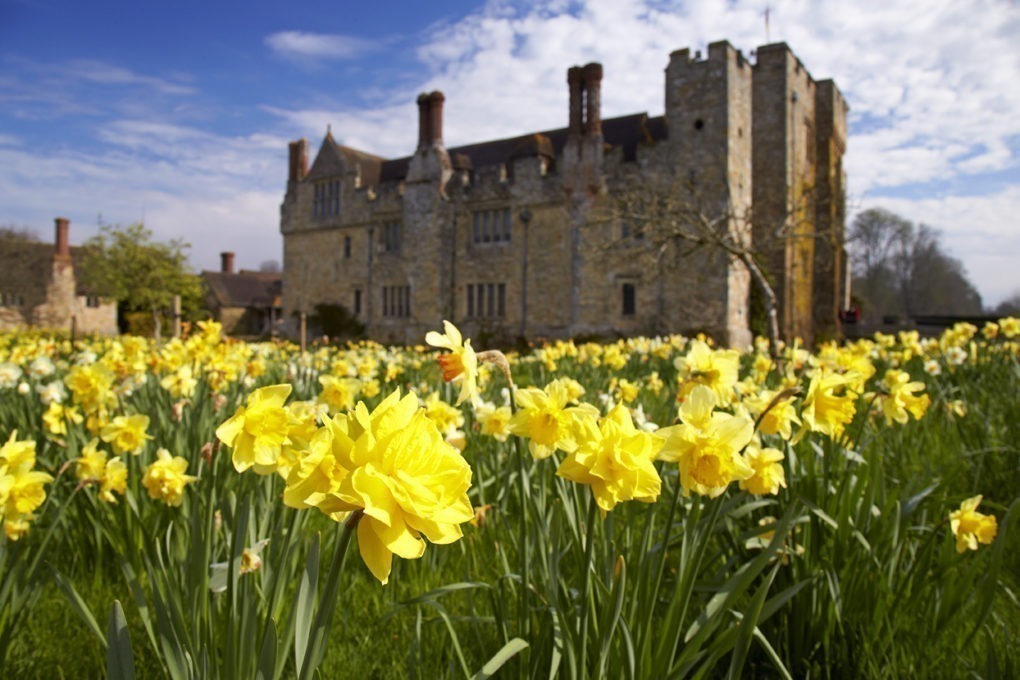

You don’t need to plant 38,000 daffodils (although we have!) to produce a dazzling display; if you attend well to the golden trumpets of the flower world, they will reward you with displays for years to come.
Gardening friends of mine speak of daffodils that have bloomed for decades in their back gardens and it’s not unknown for daffodil bulbs to out-grow their owners. We have daffodils currently blooming in Anne Boleyn’s spectacular orchard which are among the oldest on the estate. I suspect that they are unlikely to be the first bulbs planted in Tudor times, but may very well be clones of them. We have: Rip van Winkle (pre 1884), Sealing Wax (1957), Ice Follies (1953), Jetfire (1966) Tete-Tete (1949), Minnow (1962), Pheasant’s Eye (1768) and Van Sion (pre 1620).
If you want to grow perfect daffodils then you can do no better than learn from the master – Johnny Walkers – a man who has achieved narcissus perfection show after show. Johnny’s drive to produce the perfect display is unrelenting and has led to him winning RHS gold medals. I was lucky enough to work with Johnny when we launched Dazzling Daffodils and he’s also returning this March so I’m hoping to learn even more.
Bulb husbandry is a strict business and there’s the unbreakable rule: never cut or tie your daffodils after flowering, leave them to die down naturally. If you tie them or stress them they will die – remember, a bulb is a plant and needs careful tending. If you leave the leaves for 6 to 8 weeks after flowering then the plant can do it’s work and the energy can return to the bulb. Once you’re sure the energy has returned to the bulbs you can remove the dead leaves by trimming them at the base or twisting lightly.
Johnny Walkers suggests that daffodil growers feed their bulbs after flowering with a low nitrogen fertiliser.
Come the end of April, you can lift and divide the clumps if you feel that flowering is sparse or conversely if your plants have become too busily congested.
If you are growing daffodils in pots, then make sure you check the soil regularly – it should feel moist. Don’t let the soil dry out. If we experience a dry spring it’s just as well to water your daffodils to keep them happy. They can tolerate wet quite well – we have quite a lot of daffodils who enjoy dip-ping their roots in the Outer Moat at Hever.
Daffodils are poisonous to pets, so make sure your pooches don’t find any littering the garden – if they chew on them you could find yourself with a big vet bill.
Unlike their near seasonal neighbours the tulip, daffodils aren’t attractive to squirrels or rodents but they do sometime suffer from fungal infections and viruses. One such virus – the ‘Narcissus yellow stripe’ causes daffodil leaves to display yellow streaks. If your plants display a distinct lack of en-ergy with distorted stems then they may be suffering from a daffodil virus. Viruses won’t kill the plant but they will cause them to look lacklustre. There are no cures for daffodil viruses, so any suspect plants should be destroyed. If you find your stock has been affected by a virus it’s important to source good plants from reputable stockists and to plant in an area where daffodils haven’t been grown before to reduce the risk of nematode-transmitted viruses.
March is a very uplifting time for gardeners – the promise of things to come is right in front of us, and the blooming of the daffodils really does put a spring in your step. It’s one of those plants you can’t help bringing in doors and putting in a vase. If you are cutting daffodils to bring indoors, they should be kept alone in a vase: the fluid that secretes from within the stem is know to wilt other flowers.
The Castle, restaurant and gardens at Hever hold a golden glow thanks to the narcissus this month. Don’t just take my word for it, come along and see our display, and if you manage to make it on the 16th – 18th March 2020, you’ll get the chance to take a tour with bulb legend Johnny Walkers and glean more narcissus knowledge from the master.
In summary:
1. Never cut or tie the daffodils, leave them to die back naturally
2. Once the leaves have died back you can trim them at the base
3. Feed in April
4. Lift, split and move if you’re suffering overcrowding or you are unhappy with the display
5. Don’t let your daffodils dry out when they’re in bloom
6. Keep away from pets
7. Give your daffodils a vase to themselves!
Come and see Hever Castle’s Dazzling Daffodils from 16 – 22 March 2020.
Book your visit to Hever Castle & Gardens.
Within the grounds of the Hever Castle Estate, there are two opportunities for you to stay the night with us.
Hever Castle has played host to many important events and celebrations for over 600 years. In 1903 when William Waldorf Astor set about restoring Hever Castle to its former glory, he added the Astor Wing, to accommodate his family and guests, before creating a lake and the spectacular Italian Garden to house his impressive collection of ancient Greek and Roman statuary.
There are multiple places to eat & drink across the Hever Castle Estate. Select between the Castle & Gardens and Golf Club below to discover more.
Set in the mature grounds of the Hever Castle Estate, Hever Castle Golf Club is a 27 hole Kent golf course that will encourage and inspire all golf enthusiasts.
Set in the mature grounds of the Hever Castle Estate, the Wellbeing Centre consists of five smart treatment rooms.